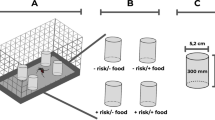Abstract
Parasites are usually assumed to negatively affect fitness components of their hosts, particularly during adverse environmental conditions. We experimentally tested whether the ectoparasitic house martin bug (Oeciacus hirundinis) had larger negative effects on its house martin (Delichon urbica) host during second clutches. Conditions for reproduction decreased during the season, being less favourable for the second clutch than the first clutch. This was demonstrated by smaller clutch sizes, lower breeding success and smaller and lighter nestlings during the second clutch, as compared to the first, in the absence of parasites. Experimental manipulation of the intensity of parasitism resulted in the reproductive success of the host being reduced with increasing numbers of house martin bugs. This effect was much stronger during the second, as compared to the first, clutch. The house martin bug therefore had a greater detrimental effect on the reproduction of its host when conditions for reproduction were poor.
Similar content being viewed by others
References
Blondel J, Gosler A, Lebreton JD, McCleery R (es) Population biology of passerine birds: an integrated approach. Springer Berlin Heidelberg New York
Boycott JA (1971) Natural history of infectiuous disease. Edward Arnold, London
Brown CR, Brown MB (1986) Ectoparasitism as a cost of coloniality in cliff swallows (Hirundo pyrrhonota). Ecology 67: 1206–1218
Bryant DM (1975) Breeding biology of house martins in relation to aerial insect abundance. Ecology 117 180–216
Burdon JJ (1987) Diseases and plant population biology. Cambridge University Press, Cambridge
Burgerjon JJ (1964) Some census notes on a colony of South African cliff swallows Petrochelidon spilodera (Sundevall). Ostrich 35: 77–85
Burnet M, White DO (1972) Natural history of infectious disease, 4th edn. Cambridge University Press, Cambridge
Cox FEG (1982) Modern parasitology. Blackwell, Oxford
Cramp S (ed) (1988) The birds of the Western Palearctic, vol 5. Oxford University Press, Oxford
Gaines SD, Rice WR (1990) Analysis of biological data when there are ordered expectations. Am Nat 135: 310–317
Glutz von Blotzheim UN, Bauer KM (eds) (1985) Handbuch der Vögel Mitteleuropas, vol 10. Akademische Verlagsgesellschaft, Wiesbaden
Godfray HCJ, Partridge L, Harvey PH (1991) Clutch size. Annu Rev Ecol Syst 22: 409–429
Hoogland JL, Sherman PW (1976) Advantages and disadvantages of bank swallow (Riparia riparia) coloniality. Ecol Monogr 46: 33–58
Kennedy CR (1976) Ecological aspects of parasitology. North-Holland, Amsterdam
Klomp H (1970) The determination of clutch-size in birds: a review. Ardea 58: 1–124
Lack D (1966) Population studies of birds. Clarendon, Oxford
Lope F de (1983) La avifauna de las Vegas Bajas del Guadiana. Doñana Acta Vert 10: 91–121
Lope F de, Silva E da (1988) La fidelidad al lugar de nidificación o de nacimiento en el avión común (Delichon urbica). Aredeola 35: 51–58
Lope F de, Møoller AP (1993) Effects of ectoparasites on reproduction of their swallow hosts: a cost of being multi-brooded. Oikos (in press)
Loye JE, Zuk M (eds) (1991) Bird-parasite interactions: ecology, evolution, and behavior. Oxford University Press, Oxford
Magrath RD (1991) Nestling weight and juvenile survival in the blackbird, Turdus merula. J Anim Ecol 60: 335–351
Marshall AG (1981) The ecology of ectoparasitic insects. Academic Press, London
Møller AP (1990) Effects of parasitism by a haematophagous mite on reproduction in the barn swallow. Ecology 71: 2345–2357
Møller AP (1991) Ectoparasite loads effect optimal clutch size in swallows. Funct Ecol 5: 351–359
Møller AP (1993a) Parasites as an environmental component of reproduction in birds. Ardea (in press)
Møller AP (1993b) Ectoparasites enhance the cost of reproduction in their hosts. J Anim Ecol 62: 309–322
Møller AP, Allander K, Dufva R (1990) Fitness effects of parasites on passerine birds: a review. In: Blondel J, Gosler A, Lebreton JD, McCleery R (eds) Population biology of passerine birds: an integrated approach. Springer, Berlin Heidelberg New York, pp 269–280
Morse DH (1980) Behavioral mechanisms in ecology. Harvard University Press, Cambridge, Mass
Moss WW, Camin JH (1970) Nest parasitism, productivity, and clutch size in purple martins. Science (Wash) 168: 1000–1003
Noble ER, Noble GA (1976) Parasitology, 4th edn. Lea and Febiger, Philadelphia
Noble ER, Noble GA, Schad GA, MacInnes AJ (1989) Parasitology: the biology of animal parasites. Lea and Febiger, Philadelphia
Országh I, Krumpal MV, Cyprich D (1990) Contribution to the knowledge of the martin bug Oeciacus hirundinis (Heteroptera, Cimicidae) in Czecholovakia. Zb Slov Nár Múz Prir Vedy 36: 43–60
Pajuelo L, Lope F de (1993) Biología de la reproducción del avión común (Delichon urbica) en Badajoz, España. Aredeola (in press)
Péricart J (1972) Hémipteres: Anthocoricidae, Cimicidae, Microphysidae de l'Ouest-Paléarctique. Masson et Cie, Paris
Price PW (1980) Evolutionary biology of parasites. Princeton University Press, Princeton
Przystalski A (1988) Morphometry of alimentary canal in some passerine birds (Passeriformes). Przegl Zool 31: 139–157
Rothschild M, Clay T (1952) Fleas, flukes and cuckoos: a study of bird parasites. Collins, London
Shields WM, Crook JR (1987) Barn swallow coloniality: a net cost for group breeding in the Adirondacks? Ecology 68: 1373–1386
Author information
Authors and Affiliations
Rights and permissions
About this article
Cite this article
de Lope, F., González, G., Pérez, J.J. et al. Increased detrimental effects of ectoparasites on their bird hosts during adverse environmental conditions. Oecologia 95, 234–240 (1993). https://doi.org/10.1007/BF00323495
Received:
Accepted:
Issue Date:
DOI: https://doi.org/10.1007/BF00323495




